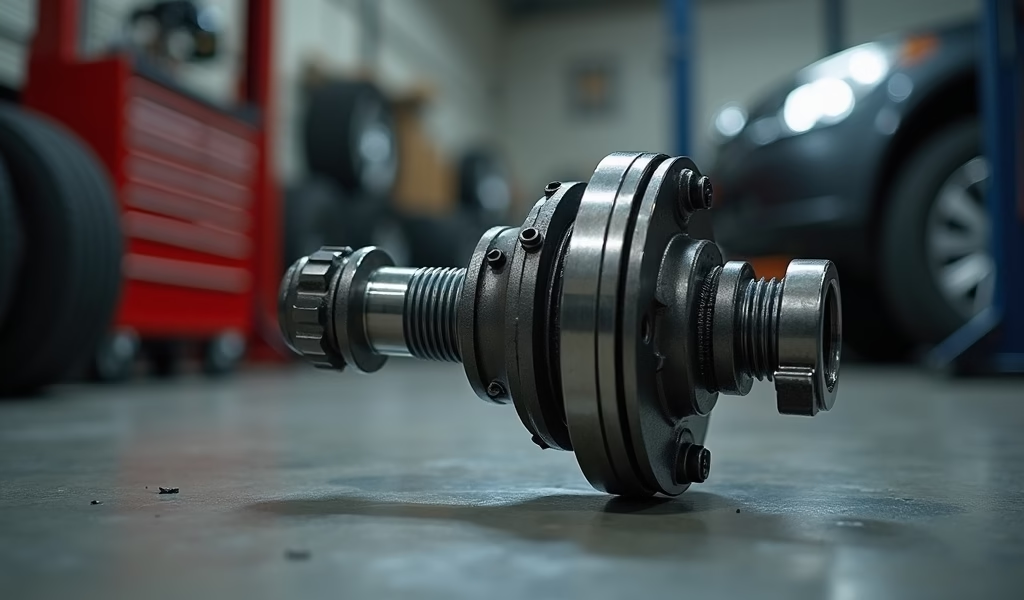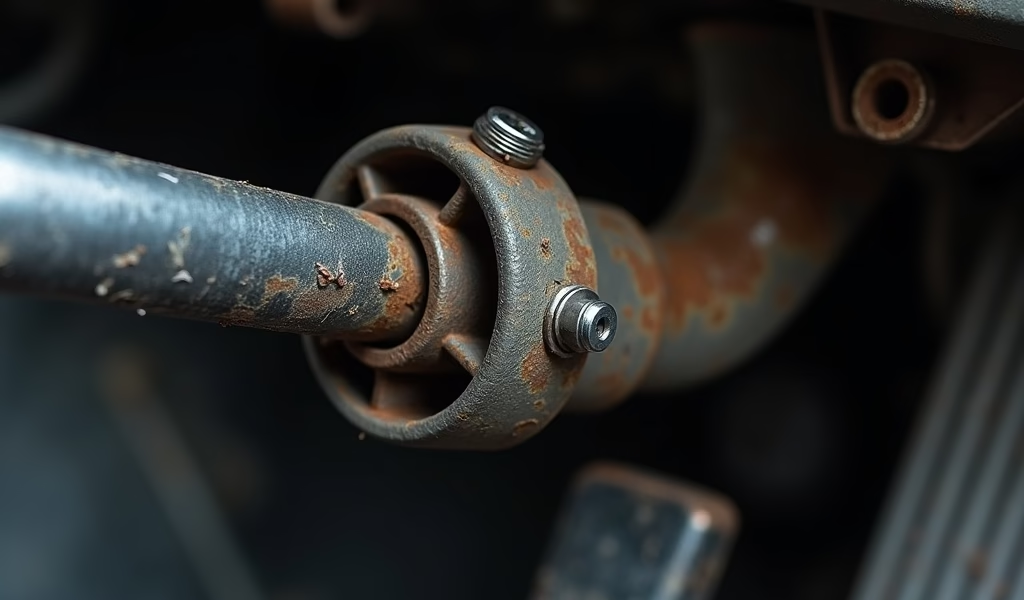Overview
This article provides five essential tips for maintaining steering column universal joints, including regular inspection, proper lubrication, addressing steering play, choosing quality replacement parts, and professional installation considerations. It emphasizes how proper maintenance of this critical steering component can prevent dangerous failures, extend service life, and ensure safe vehicle operation.
Table of Contents
- Understanding Steering Column Universal Joints
- Signs of a Failing Steering Column Universal Joint
- Tip 1: Regular Inspection and Maintenance
- Tip 2: Proper Lubrication Techniques
- Tip 3: Addressing Steering Column Play
- Tip 4: Quality Replacement Parts
- Tip 5: Professional Installation Considerations
- Conclusion
- Frequently Asked Questions
Understanding Steering Column Universal Joints
The steering column universal joint is a crucial component in your vehicle’s steering system that often goes unnoticed until problems arise. This small but mighty part connects the steering wheel to the steering rack, allowing for smooth directional changes while compensating for the angles between these components. Without a properly functioning steering column universal joint, you’d find it difficult or impossible to steer your vehicle effectively.
Think of this joint as the middleman in a conversation between your hands and the wheels. When you turn the steering wheel, the universal joint transfers that rotational force through the steering column down to the steering rack and pinion system. This seemingly simple task requires a component that can handle constant movement, stress, and vibration.
Most modern vehicles use one or more universal joints (often called U-joints) in their steering columns. These joints typically consist of a cross-shaped central piece with bearings at each end, allowing for multi-directional movement. The design permits the steering shaft to change angles while maintaining a consistent transfer of rotational force.
Like all mechanical components, steering column universal joints wear over time. Road conditions, driving habits, and maintenance practices all influence how quickly this wear occurs. Understanding how to properly maintain and recognize issues with your universal joint can save you from expensive repairs and potentially dangerous driving situations.
Signs of a Failing Steering Column Universal Joint
Recognizing the warning signs of a deteriorating steering column universal joint can help you address issues before they become serious problems. The most common indicator is unusual noise when turning the steering wheel. This might present as clicking, clunking, or grinding sounds that occur specifically during steering maneuvers.
Another telltale sign is steering wheel play or looseness. If your steering wheel feels like it needs to travel farther before the wheels respond, or if there’s noticeable “slop” in the steering, your universal joint may be wearing out. This looseness typically worsens over time if left unaddressed.
You might also notice steering feedback changes. A failing universal joint can cause vibrations to transfer through the steering column to the steering wheel. These vibrations might be subtle at first but tend to intensify as the joint deteriorates further.
Difficulty turning the steering wheel, especially at low speeds or when the vehicle is stationary, can indicate universal joint issues. This may feel like stiffness or binding when attempting to turn. If you experience any of these symptoms, it’s wise to have your vehicle inspected by a qualified mechanic as soon as possible.
In more severe cases, you may notice your steering becoming inconsistent or unpredictable. This is a serious safety concern that requires immediate attention. According to a National Highway Traffic Safety Administration report, steering system failures contribute to thousands of accidents annually.

Tip 1: Regular Inspection and Maintenance
Regular inspection of your steering column universal joint should be part of your vehicle’s maintenance routine. I recommend checking this component at least twice a year or every 10,000 miles, whichever comes first. These inspections can often prevent costly repairs down the road.
To properly inspect the universal joint, you’ll need to locate it first. In most vehicles, it’s positioned near where the steering column passes through the firewall into the engine compartment. You may need to remove covers or shields to access it fully.
During your inspection, look for these key issues:
- Excessive play or movement in the joint
- Rust or corrosion on the joint components
- Damaged or missing dust seals
- Dried-out or missing lubricant
- Visible wear on the cross bearing components
Physical inspection should include gently testing the joint for movement. With the wheels straight and the engine off, try moving the steering column near the joint location. You should feel minimal play. Excessive movement indicates wear that needs addressing.
Maintenance of the universal joint primarily involves keeping it clean and properly lubricated. Road grime and moisture are the enemies of these components. Use a clean cloth to wipe away any accumulated dirt, being careful not to damage any seals or bearings.
If you’re not comfortable performing this inspection yourself, have it done during regular service appointments. Most mechanics will include steering system checks as part of comprehensive vehicle inspections. Just be sure to specifically request that they examine the steering column universal joint.
Tip 2: Proper Lubrication Techniques
Proper lubrication is perhaps the most important aspect of maintaining your steering column universal joint. Many modern vehicles come with sealed universal joints that are “lubricated for life,” but this doesn’t mean they’ll never need attention. Even sealed units can benefit from external application of appropriate lubricants.
For serviceable universal joints with grease fittings (also called zerk fittings), regular lubrication is essential. Use a high-quality lithium-based or moly-based grease that’s designed for chassis components. These greases stand up well to the pressures and temperatures experienced by steering components.
The lubrication process involves these steps:
- Locate the grease fitting on the universal joint
- Clean the fitting to prevent introducing contaminants
- Attach a grease gun to the fitting
- Pump grease in slowly until you see fresh grease emerging from the seals
- Wipe away excess grease to prevent attracting dirt
For sealed joints without grease fittings, external lubrication of accessible moving parts can still help. A penetrating lubricant with PTFE (such as those recommended by SAE International studies) can be applied to exposed portions of the joint to help reduce friction and wear.
Be mindful of over-lubrication, which can be almost as problematic as under-lubrication. Excess grease can rupture seals, attract abrasive contaminants, and create a mess in your engine bay. Apply just enough to ensure proper function.
The frequency of lubrication depends on your driving conditions. Vehicles driven in harsh environments (dusty, wet, or extreme temperatures) should receive lubrication more frequently than those in moderate conditions. As a general rule, lubrication every 10,000-15,000 miles is appropriate for most vehicles.
Tip 3: Addressing Steering Column Play
Excessive play in your steering system not only affects driving comfort but also poses safety concerns. When it comes to the steering column universal joint, play can develop gradually as components wear. Addressing this issue promptly prevents accelerated wear of related components.
First, determine if the play is indeed coming from the universal joint. With the engine off and wheels straight, have someone gently rock the steering wheel back and forth while you observe the universal joint. Any visible movement or clunking at the joint indicates wear that needs addressing.
Minor play can sometimes be addressed by tightening connections. Check the fasteners that secure the universal joint to both the steering column and the intermediate shaft. These bolts or pins may loosen over time due to vibration. Use the manufacturer’s torque specifications when tightening these fasteners to avoid damage.
If tightening doesn’t resolve the issue, the universal joint itself may be worn beyond adjustment. In this case, replacement becomes necessary. Some vehicles use universal joints that allow for adjustment via a pinch bolt or clamp. These designs may provide some ability to remove play without full replacement.
When addressing steering play, consider the entire steering system. Problems elsewhere in the system can manifest in ways that mimic universal joint issues. Common culprits include:
- Worn tie rod ends
- Loose rack and pinion mounts
- Worn steering column bearings
- Deteriorated suspension components
A comprehensive inspection by a qualified mechanic can pinpoint the exact source of steering play. This approach prevents unnecessary parts replacement and ensures that the true cause is addressed.

Tip 4: Quality Replacement Parts
When the time comes to replace your steering column universal joint, the quality of the replacement part significantly impacts both performance and longevity. Not all replacement joints are created equal, and this is one area where cutting corners can lead to safety concerns.
OEM (Original Equipment Manufacturer) parts generally offer the best fit and durability. These parts are made to the same specifications as the original components in your vehicle. While they typically cost more than aftermarket alternatives, the investment often pays off through longer service life and better performance.
If you opt for aftermarket parts, research brands with established reputations for quality. Look for parts that meet or exceed OEM specifications. Reputable aftermarket manufacturers often use higher-quality materials than the originals, potentially offering improved durability.
Key factors to consider when selecting a replacement universal joint include:
- Material quality (heat-treated steel is preferable)
- Bearing design and quality
- Seal effectiveness
- Lubrication provisions
- Warranty coverage
Be wary of unusually inexpensive universal joints. These often use inferior materials that wear quickly or fail prematurely. The cost difference between economy and quality parts is typically small compared to the labor involved in replacement, making higher quality the sensible choice.
Some vehicles benefit from upgraded universal joint designs. For instance, heavy-duty or greasable replacements might offer advantages for vehicles subjected to harsh conditions. Consult with a knowledgeable parts specialist or mechanic to determine if such upgrades would benefit your specific vehicle.
When purchasing replacement parts, ensure you have the correct specifications. Universal joints come in various sizes and configurations. Vehicle-specific parts catalogs or databases can help identify the exact part needed for your make, model, and year.
Tip 5: Professional Installation Considerations
While replacing a steering column universal joint might seem straightforward, professional installation offers several advantages. Steering system work directly affects vehicle control and safety, making proper installation crucial.
Professional mechanics have the specialized tools needed for proper universal joint installation. These might include joint presses, spline alignment tools, and torque wrenches calibrated to the manufacturer’s specifications. Attempting this work without proper tools risks damaging components or creating unsafe conditions.
Experienced technicians also understand the subtle aspects of proper installation, such as:
- Correct orientation of the universal joint
- Proper phasing of multiple joints
- Appropriate torque application to fasteners
- Verification of free movement without binding
- System alignment checks after installation
If you decide to tackle this job yourself, invest time in research first. Factory service manuals provide the most accurate procedures for your specific vehicle. Online repair databases like AllData offer detailed, model-specific guidance for many repair procedures.
Safety should always be your primary concern when working on steering components. Use proper jack stands when working under the vehicle, and never rely solely on a jack for support. Disconnect the battery before beginning work to prevent accidental airbag deployment, which can occur when manipulating the steering column in many modern vehicles.
After installation, thorough testing is essential. This should include stationary checks of steering movement, followed by careful road testing in a safe area. Pay attention to any unusual feelings, sounds, or behaviors in the steering system. If anything seems off, return to your workspace for further inspection rather than risking highway speeds.
Remember that steering system work often requires alignment afterward. Even if the universal joint replacement itself doesn’t directly affect alignment angles, related disassembly might. A professional alignment ensures your vehicle tracks straight and wears tires evenly.
Conclusion
The steering column universal joint may be small, but its role in your vehicle’s handling and safety is significant. Through regular inspection, proper lubrication, addressing play promptly, selecting quality parts, and considering professional installation, you can ensure this critical component serves you well for many miles.
Preventative maintenance is always more economical than emergency repairs. By incorporating steering system checks into your regular maintenance routine, you’ll catch small issues before they develop into major problems. This approach not only saves money but also prevents potentially dangerous failures while driving.
Remember that steering system health directly impacts your safety on the road. When something doesn’t feel right in your steering, don’t postpone getting it checked. The minor inconvenience of a service appointment is nothing compared to the risks of steering failure at speed.
Whether you’re a DIY enthusiast or prefer professional service, understanding your vehicle’s steering components helps you make informed decisions about maintenance and repairs. This knowledge empowers you to communicate effectively with service providers and ensure your vehicle receives proper care.
With these five tips, you’re well-equipped to maintain your steering column universal joint and enjoy responsive, reliable steering for years to come. Happy and safe driving!
Frequently Asked Questions
How long does a steering column universal joint typically last?
With proper maintenance, a steering column universal joint can last 100,000 to 150,000 miles. Driving conditions, maintenance practices, and vehicle design all influence actual lifespan.
Can I drive with a bad steering column universal joint?
Driving with a failing universal joint is unsafe and not recommended. A complete failure could result in loss of steering control and a potential accident.
How much does it cost to replace a steering column universal joint?
Replacement costs typically range from $150 to $500 depending on vehicle make and model. Parts usually cost $30-$150, with labor making up the remainder.
Will a bad universal joint affect my vehicle’s alignment?
A worn universal joint doesn’t directly affect alignment angles but can create steering inconsistency that mimics alignment issues. After replacement, an alignment check is still recommended.
Can I replace just the universal joint or do I need to replace the entire steering column?
In most vehicles, the universal joint can be replaced separately without replacing the entire steering column. Some luxury or specialty vehicles may have design limitations that require more extensive replacement.

